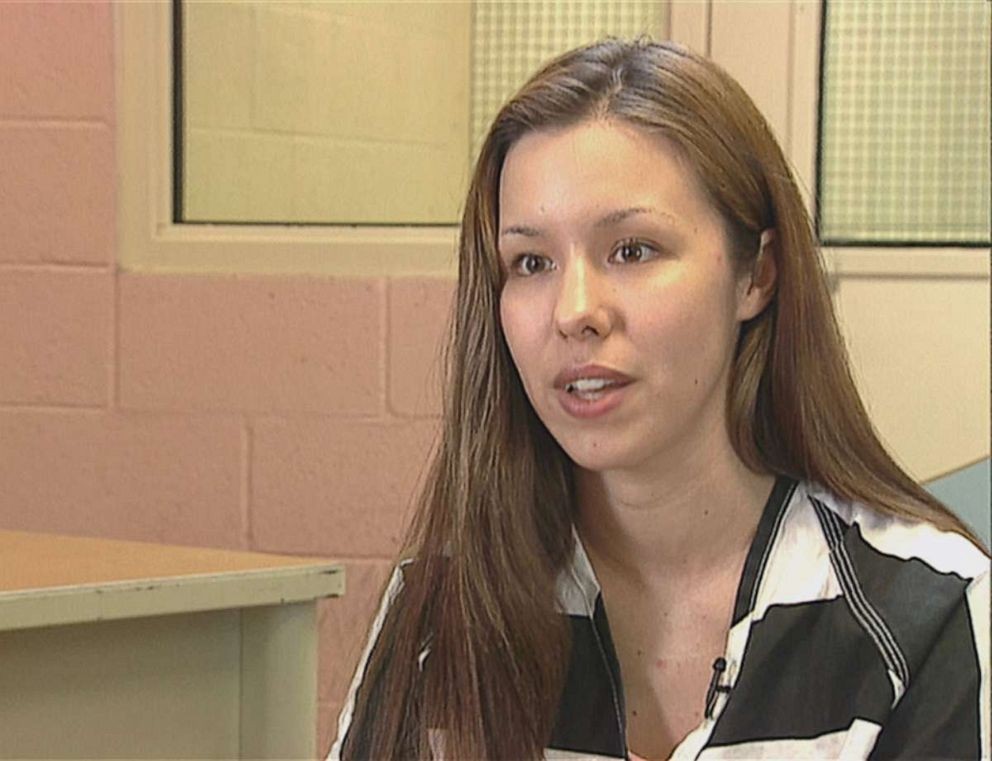Did Jodi Arias kill Travis Alexander? This tragic case continues to fascinate and horrify. At WHY.EDU.VN, we delve into the motives, evidence, and lasting impact of this infamous crime. Explore the complexities of the Jodi Arias trial and the underlying factors that led to the death of Travis Alexander. The details and background of their relationship will be revealed, including the controversial self-defense claim and the disturbing facts that emerged during the murder trial.
1. The Ill-Fated Relationship Between Jodi Arias and Travis Alexander
Jodi Arias and Travis Alexander’s relationship began in 2006 and quickly turned tumultuous. Their initial connection seemed promising, but beneath the surface lay a complex web of religious differences, jealousy, and escalating tensions.
1.1 Initial Attraction and Religious Differences
Jodi Arias, a 26-year-old aspiring photographer, met Travis Alexander, a 29-year-old motivational speaker and devout Mormon, at a company convention in Las Vegas. Friends described their connection as instant. Alexander was deeply involved in his faith, while Arias was not. Despite this, Arias converted to Mormonism shortly after they met and was baptized by Alexander. However, the couple engaged in premarital sex, violating one of the key tenets of the Mormon faith.
The religious differences and the guilt associated with their actions created tension in their relationship. As Colleen McDannell, a professor of religious studies at the University of Utah, explained, Mormons consider sex outside of marriage forbidden, viewing the body as a sacred space given by God.
1.2 Red Flags and Alarming Behavior
Early in the relationship, Alexander’s friends noticed troubling signs in Arias’ behavior. They reported that she exhibited obsessive tendencies, possessiveness, and a disturbing level of infatuation.
- Arias would constantly seek Alexander’s attention and become jealous when he spoke to other women.
- She would follow him to the bathroom and eavesdrop on his conversations.
- Arias accessed Alexander’s phone, emails, and social media accounts, forwarding his emails with other women to herself.
These behaviors raised concerns among Alexander’s friends, who warned him about Arias’ potentially dangerous tendencies.
1.3 The Breakup and Continued Contact
After five months, Alexander ended the relationship. However, Arias moved to Mesa, Arizona, where he lived, causing further unease among his friends. Despite the breakup, Arias and Alexander continued to communicate, engaging in phone sex and maintaining a complex dynamic. Steven Alexander, Travis’s brother, referred to Arias as his brother’s “kryptonite,” suggesting she had a strong hold over him.
2. The Murder of Travis Alexander
On June 9, 2008, Travis Alexander was found dead in his Mesa, Arizona, home. The gruesome crime scene revealed a brutal attack, with Alexander stabbed multiple times, his throat slashed, and a gunshot wound to the head.
2.1 Discovery of the Body and Initial Investigation
Alexander’s friends became concerned when he missed a conference call and failed to respond to messages before a planned trip to Cancun. They went to his house, where they found his roommate, Zach Billings, who claimed Alexander was in Mexico. However, Alexander was found dead in the shower.
Police detective Esteban Flores described the scene as indicative of a major struggle and deeply personal attack. Alexander had been dead for several days. The autopsy revealed he had been stabbed 27 times and shot.
2.2 Key Evidence and Arias as a Suspect
Investigators found several pieces of evidence at the crime scene that pointed to Jodi Arias as the prime suspect:
- A bloody palm print matching Arias’ was found outside Alexander’s bedroom.
- Long brown hairs were discovered on the bathroom floor and walls.
- A camera was found in the washing machine.
The memory card from the camera contained photos of Arias and Alexander timestamped from the day of the murder. Initially, Arias denied being in Arizona at the time of the murder. However, she later admitted to being at Alexander’s home but claimed she was attacked by masked intruders.
3. The Jodi Arias Trial: A Media Sensation
The Jodi Arias trial became a media sensation, captivating the public with its shocking details and dramatic courtroom moments. The trial, which began in January 2013, lasted for months and featured conflicting testimonies, graphic evidence, and intense legal arguments.
3.1 Arias’ Conflicting Accounts
Throughout the investigation and trial, Jodi Arias provided several conflicting accounts of the events leading to Travis Alexander’s death. Initially, she denied being in Arizona. Later, she claimed that masked intruders had killed Alexander. Finally, she testified that she killed Alexander in self-defense after he attacked her.
3.2 Self-Defense Claim and Abuse Allegations
Arias claimed that Alexander had become angry after she dropped the camera, leading to a violent confrontation in which she feared for her life. She alleged that Alexander had been physically abusive towards her on previous occasions and that she had found him viewing child pornography.
The prosecution disputed these claims, presenting evidence that contradicted Arias’s testimony and portraying her as a manipulative and obsessive individual. Steven Alexander stated that his brother did not even own a gun and that her self-defense story was a joke.
3.3 Jury Verdict and Sentencing
In May 2013, the jury found Jodi Arias guilty of first-degree murder in Travis Alexander’s death. However, the jury was deadlocked on whether to impose the death penalty, leading to a mistrial in the sentencing phase.
A second jury also failed to reach a unanimous decision on the death penalty. As a result, in 2015, a judge sentenced Arias to life in prison without the possibility of parole.
4. The Aftermath and Lasting Impact
The murder of Travis Alexander and the subsequent trial of Jodi Arias had a profound impact on the families and friends involved, as well as the wider public.
4.1 Impact on the Alexander Family
The Alexander family endured immense grief and suffering as a result of Travis’s murder. Steven Alexander expressed his pain and frustration with Arias’s attempts to tarnish his brother’s reputation during the trial. He emphasized the injustice of Travis being deprived of a future with a family and happiness.
4.2 Arias’ Life in Prison and Appeals
Jodi Arias is currently serving her life sentence at the Perryville Prison in Arizona. She has filed appeals challenging her conviction, alleging prosecutorial misconduct and other improprieties. However, as of now, her appeals have been unsuccessful.
5. Unveiling the Motives: Why Did Jodi Arias Kill Travis Alexander?
The question of why Jodi Arias killed Travis Alexander remains a subject of intense speculation and debate. While the trial provided some insights into their relationship and the events leading up to the murder, a definitive answer to the motive remains elusive.
5.1 Obsession, Jealousy, and Control
One theory suggests that Arias’s actions were driven by a combination of obsession, jealousy, and a desire for control over Travis Alexander. Her possessive behavior, stalking, and attempts to isolate Alexander from his friends and family indicate a deep-seated need to control his life.
5.2 Rejection and Revenge
Another possible motive is that Arias killed Alexander out of anger and revenge after he rejected her and attempted to move on with his life. The breakup and Alexander’s pursuit of other women may have fueled Arias’s resentment and led her to commit the ultimate act of violence.
5.3 Mental Instability
Some experts have suggested that Jodi Arias may have been suffering from underlying mental health issues that contributed to her actions. While mental illness does not excuse her crime, it may provide some context for understanding her behavior.
6. Expert Opinions on the Motives
The motives behind Jodi Arias’s actions have been a topic of discussion among experts, including psychologists, criminologists, and legal analysts. They offer various perspectives on the factors that may have contributed to the murder of Travis Alexander.
6.1 Psychological Analysis
Psychologists have analyzed Arias’s personality and behavior, suggesting that she may exhibit traits of borderline personality disorder, narcissistic personality disorder, or other mental health conditions. These conditions can lead to emotional instability, impulsivity, and difficulty maintaining healthy relationships.
6.2 Criminological Perspectives
Criminologists have examined the case through the lens of criminal behavior, exploring the potential role of factors such as jealousy, rage, and a desire for control in motivating Arias’s actions. They may also consider the influence of media coverage and public attention on her behavior.
6.3 Legal Insights
Legal analysts have focused on the legal aspects of the case, including the evidence presented at trial, the arguments made by both sides, and the jury’s verdict. They may offer insights into the legal strategies employed and the challenges faced by the prosecution and defense.
7. Key Points from the Trial
The Jodi Arias trial was marked by several key moments and pieces of evidence that shaped the outcome of the case.
7.1 The Bloody Crime Scene Photos
The graphic photographs of the crime scene, showing Travis Alexander’s lifeless body and the extent of his injuries, had a powerful impact on the jury. These images served as a stark reminder of the violence and brutality of the crime.
7.2 Arias’s Inconsistent Testimonies
Arias’s changing stories and inconsistent testimonies undermined her credibility with the jury. Her initial denials, followed by claims of self-defense and allegations of abuse, raised doubts about her truthfulness and motives.
7.3 The Camera and Memory Card Evidence
The discovery of the camera in the washing machine and the photos on the memory card were crucial pieces of evidence. The timestamped images of Arias and Alexander on the day of the murder contradicted her initial claims and placed her at the scene of the crime.
8. The Evolving Legal Landscape
The Jodi Arias case has raised important questions about domestic violence, self-defense, and the role of mental health in criminal proceedings. It has also sparked discussions about the impact of media coverage on high-profile trials and the challenges of ensuring a fair trial in the face of intense public scrutiny.
8.1 Influence on Future Cases
The legal precedents and strategies used in the Jodi Arias trial may influence future cases involving similar issues. Lawyers may study the case to learn from the successes and failures of both the prosecution and defense.
8.2 Public Perception of Justice
The Jodi Arias case has shaped public perception of the criminal justice system and the challenges of achieving justice in complex and emotional cases. It has also raised awareness about domestic violence and the importance of seeking help for those in abusive relationships.
9. FAQs About the Jodi Arias Case
Here are some frequently asked questions about the Jodi Arias case, providing concise answers to common inquiries.
- What was Jodi Arias convicted of? Jodi Arias was convicted of first-degree murder in the death of Travis Alexander.
- What was Jodi Arias’s motive? Jodi Arias’s motive is believed to be a combination of obsession, jealousy, and revenge after Travis Alexander ended their relationship.
- What evidence was used against Jodi Arias? Key evidence included bloody crime scene photos, Arias’s inconsistent testimonies, and camera evidence placing her at the scene.
- Did Jodi Arias claim self-defense? Yes, Jodi Arias claimed she killed Travis Alexander in self-defense after he allegedly attacked her.
- What is Jodi Arias’s sentence? Jodi Arias was sentenced to life in prison without the possibility of parole.
- Where is Jodi Arias now? Jodi Arias is currently serving her sentence at Perryville Prison in Arizona.
- Did the jury agree on the death penalty? No, the jury deadlocked on the death penalty, resulting in a life sentence.
- What was the relationship between Jodi Arias and Travis Alexander? The relationship was tumultuous, marked by religious differences, jealousy, and escalating tensions.
- How did Travis Alexander die? Travis Alexander was stabbed multiple times, his throat was slashed, and he was shot in the head.
- What was Arias’s initial alibi? Initially, Jodi Arias denied being in Arizona at the time of Travis Alexander’s death.
10. Conclusion: The Lingering Questions
The Jodi Arias case remains a complex and controversial chapter in true crime history. While Jodi Arias was convicted of the murder of Travis Alexander, the underlying motives and circumstances surrounding the crime continue to fascinate and provoke discussion. The case serves as a stark reminder of the destructive potential of obsession, jealousy, and unchecked emotions.
The tragedy highlights the importance of recognizing red flags in relationships and seeking help for those who may be at risk of violence. It also underscores the challenges of achieving justice in cases where conflicting accounts and complex psychological factors are at play. As time passes, the Jodi Arias case will likely continue to be analyzed, debated, and remembered as a cautionary tale of love gone wrong.
Are you seeking answers to complex questions or need expert insights? Visit WHY.EDU.VN today! Our team of experts is ready to provide you with comprehensive and reliable answers. Contact us at 101 Curiosity Lane, Answer Town, CA 90210, United States, or reach out via WhatsApp at +1 (213) 555-0101. Let why.edu.vn be your guide in the quest for knowledge.


